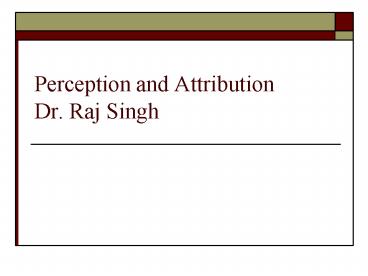Perception and Attribution Dr. Raj Singh - PowerPoint PPT Presentation
1 / 19
Title:
Perception and Attribution Dr. Raj Singh
Description:
The process by which people select, organize, interpret, retrieve, and respond to information. ... Be attuned to attributions at the interpretation stage. ... – PowerPoint PPT presentation
Number of Views:134
Avg rating:3.0/5.0
Title: Perception and Attribution Dr. Raj Singh
1
Perception and AttributionDr. Raj Singh
2
What is the perceptual process?
- Perception.
- The process by which people select, organize,
interpret, retrieve, and respond to information. - Perceptual information is gathered from
- Sight.
- Hearing.
- Touch.
- Taste.
- Smell.
3
What is the perceptual process?
- Factors influencing the perceptual process.
- Characteristics of the perceiver.
- Characteristics of the setting.
- Characteristics of the perceived.
4
What is the perceptual process?
- Characteristics of the perceiver.
- The perceptual process is influenced by the
perceivers - Past experiences.
- Needs or motives.
- Personality.
- Values and attitudes.
5
What is the perceptual process?
- Stages of the perceptual process.
- Information attention and selection.
- Organization of information.
- Information interpretation.
- Information retrieval.
6
What is the perceptual process?
- Information attention and selection.
- Selective screening.
- Lets in only a tiny proportion all the
information that bombards a person. - Two types of selective screening.
- Controlled processing.
- Screening without perceivers conscious awareness.
7
What is the perceptual process?
- Organization of information.
- Schemas.
- Cognitive frameworks that represent organized
knowledge about a given concept or stimulus
developed through experience. - Types of schemas.
- Self schemas.
- Person schemas.
- Script schemas.
- Person-in-situation schemas.
8
What is the perceptual process?
- Information interpretation.
- Uncovering the reasons behind the ways stimuli
are grouped. - People may interpret the same information
differently or make different attributions about
information.
9
What is the perceptual process?
- Information retrieval.
- Attention and selection, organization, and
interpretation are part of memory. - Information stored in memory must be retrieved in
order to be used.
10
What is the perceptual process?
- Response to the perceptual process.
- Thoughts.
- Feelings.
- Actions.
11
What are commonperceptual distortions?
- Common perceptual distortions include
- Stereotypes or prototypes.
- Halo effects.
- Selective perception.
- Projection.
- Contrast effects.
- Self-fulfilling prophecy.
12
What are commonperceptual distortions?
- Stereotypes or prototypes.
- Combines information based on the category or
class to which a person, situation, or object
belongs. - Strong impact at the organization stage.
- Individual differences are obscured.
13
What are commonperceptual distortions?
- Halo effects.
- Occur when one attribute of a person or situation
is used to develop an overall impression of the
individual or situation. - Likely to occur in the organization stage.
- Individual differences are obscured.
- Important in the performance appraisal process.
14
What are commonperceptual distortions?
- Selective perception.
- The tendency to single out those aspects of a
situation, person, or object that are consistent
with ones needs, values, or attitudes. - Strongest impact is at the attention stage.
- Perception checking with other persons can help
counter the adverse impact of selective
perception.
15
What are commonperceptual distortions?
- Projection.
- The assignment of ones personal attributes to
other individuals. - Especially likely to occur in interpretation
stage. - Projection can be controlled through a high
degree of self-awareness and empathy.
16
What are commonperceptual distortions?
- Contrast effects.
- Occur when an individual is compared to other
people on the same characteristics on which the
others rank higher or lower.
17
What are commonperceptual distortions?
- Self-fulfilling prophecy.
- The tendency to create or find in another
situation or individual that which one expected
to find. - Also called the Pygmalion effect.
- Can have either positive or negative outcomes.
- Managers should adopt positive and optimistic
approaches to people at work.
18
How can the perceptualprocess be managed?
- Impression management.
- A persons systematic attempt to behave in ways
that create and maintain desired impressions in
others eyes. - Successful managers
- Use impression management to enhance their own
images. - Are sensitive to other peoples use of impression
management.
19
How can the perceptualprocess be managed?
- Distortion management.
- Managers should
- Balance automatic and controlled information
processing at the attention and selection stage. - Broaden their schemas at the organizing stage.
- Be attuned to attributions at the interpretation
stage.































